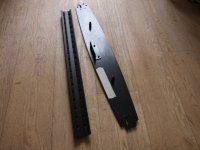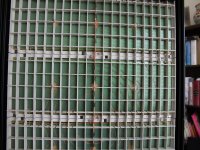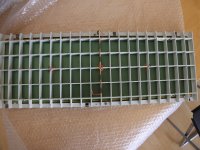In part 1 I exceeded the maximum number of pictures so here is part 2.

Undo 8 flat-head screws from the top metal plate and remove it together with the plastic hood underneath it.

Each of the 4 (2805) or 6 (2812) panels are connected with wire links and fastened with 4 self-tap screws to metal side bars.
To remove a panel desolder the wire links at the front and rear of the speaker. The HT line is on one side only. Then unscrew the 4 self-tap screws.
Very informative is the old website of One Thing Audio New Page 1

The two parts of the panel are kept together with 3 spring clips at each side and three bolts/nuts at the center of the panel. Watch the location of the spring clips.
I think that for most people these pictures and the accompanying text will suffice. The reason I took my ESL apart was that one of my diaphragms has a very very small tear or puncture. Therefore I ordered a Quad repair kit from Eraudio in Australia.

Undo 8 flat-head screws from the top metal plate and remove it together with the plastic hood underneath it.

Each of the 4 (2805) or 6 (2812) panels are connected with wire links and fastened with 4 self-tap screws to metal side bars.
To remove a panel desolder the wire links at the front and rear of the speaker. The HT line is on one side only. Then unscrew the 4 self-tap screws.
Very informative is the old website of One Thing Audio New Page 1

The two parts of the panel are kept together with 3 spring clips at each side and three bolts/nuts at the center of the panel. Watch the location of the spring clips.
I think that for most people these pictures and the accompanying text will suffice. The reason I took my ESL apart was that one of my diaphragms has a very very small tear or puncture. Therefore I ordered a Quad repair kit from Eraudio in Australia.
Thanks for posting that to the world. It is a very nice service for everyone else.
One slight difference in my method: I do not take the inner top off (first picture above); the panels can be brought out straight through the front of the speakers with that top on.
Sheldon
One slight difference in my method: I do not take the inner top off (first picture above); the panels can be brought out straight through the front of the speakers with that top on.
Sheldon
Sheldon, your way is probably better because when I removed all 4 panels the metal side bars to which the panels are fastened came tumbling down.😡
While your in there
Change out the aluminum bracket that the panels screw to, it flexes a considerable amount
You should be able to source a much thicker one easily.
When soldering/unsoldering the panel wires, slice a piece of paper and place it around the tab so no blobs find their way to the membrane. Found a couple from the factory.
Those perimeter panel clips should have been much more abundant than what Quad supplied - for shame..
An alternative source for those items would help so you can triple the amount.
Also the soft foam between the panels should be replaced with a denser double sided tape and all panels clamped together before screwing to the new bracket
Regards
David
Change out the aluminum bracket that the panels screw to, it flexes a considerable amount
You should be able to source a much thicker one easily.
When soldering/unsoldering the panel wires, slice a piece of paper and place it around the tab so no blobs find their way to the membrane. Found a couple from the factory.
Those perimeter panel clips should have been much more abundant than what Quad supplied - for shame..
An alternative source for those items would help so you can triple the amount.
Also the soft foam between the panels should be replaced with a denser double sided tape and all panels clamped together before screwing to the new bracket
Regards
David
That’s a very good one, Avwerk. I used some aluminum foil to protect the stator and membrane.When soldering/unsoldering the panel wires, slice a piece of paper and place it around the tab so no blobs find their way to the membrane. Found a couple from the factory
Those perimeter panel clips should have been much more abundant than what Quad supplied - for shame..
An alternative source for those items would help so you can triple the amount.
Regards
David
You mean these 15mm bulldog/binder clips.
Pack of 12 Black 15mm Foldback Binder Clips - Filing Binding 6937544364555 | eBay
Much easier to fit too, Just remove the finger springs after fitting.
Fit Kapton/insulation tape across the matrix beneath the clips to prevent any membrane coating coating coming into contact with them.
Also the soft foam between the panels should be replaced with a denser double sided tape and all panels clamped together before screwing to the new bracket
Regards
David
Better still throw away the old frames from your 63/9> Quads and fit the panels to 3mm angle alloy fastened to 40x 20 steel box section then run naked (the speakers 😱).
Usual disclaimer about death from exposed HIGH VOLTAGE T&C's
The increase in detail and soundstage is phenomenal. Plus the frames will never flex again aiding stator glue failure.
If you run naked you need to provide a way to keep the dust out. It will short out the HV pretty quickly and could short the audio with some serious consequences . You could set up a positive HEPA filtered air laminar flow around the speakers. It might just be too noisy but no dust and no dust cover. Maybe just built the room as a class 100 clean room. . .
Or source some much thinner film for the dust covers.
Or source some much thinner film for the dust covers.
I've run them naked for 2 years then stripped down the panels - no dust to speak of on the membranes.
Martin Logan's have no dust covers.
I vacuum the stators twice per year.
Martin Logan's have no dust covers.
I vacuum the stators twice per year.
I am of the opinion that the dust covers were fitted as a result of a perceived potential problem rather than an actual measured one.
The dust covers on the bigger 6 panel Quads are more prone to loose tension resulting in a large flapping panel in front of your speakers.
I'm in the process of making some some acoustic cloth covers, mainly for aesthetic reasons, but also to keep out dust and small flies..
The dust covers on the bigger 6 panel Quads are more prone to loose tension resulting in a large flapping panel in front of your speakers.
I'm in the process of making some some acoustic cloth covers, mainly for aesthetic reasons, but also to keep out dust and small flies..
Martin Logan's have no dust covers.
Martin Logans also have full stator insulation, which the Quads lack.
The Quads have an arc detection circuit, which the Martin Logans lack.
I don't think they're really comparable scenarios.
In a clean enough house, with enough care, and with the right conditions, you are getting away with no dust cover. That's not going to be the experience for all users though. It's not without risks to the long-term health of the speakers in more typical environments.
Quad needed to deal with a worldwide market and customers who were not necessarily careful so they probably did not feel free to offer something that had a high failure potential.
Part of the problem is that the HV will attract dust in the air. The metal screen will block some of the charge that attracts the dust. In that vein I just checked into a conductive mesh material and found a solid copper screening material that may accomplish both protection and dust resistance and possibly look good (at least for a while): Copper Mesh Screen | Replacing Window Screens | Copper Screen - Metro Screenworks
The first gen 63's had a really closed in metal screen that had a significant impact on the sound. When we swapped those for the special perforated metal screens for the Crosby quads it was interesting that Quad switched to something similar a few years later. The wire mesh may not be as sturdy and may rattle (needs testing) but could work pretty well.
Part of the problem is that the HV will attract dust in the air. The metal screen will block some of the charge that attracts the dust. In that vein I just checked into a conductive mesh material and found a solid copper screening material that may accomplish both protection and dust resistance and possibly look good (at least for a while): Copper Mesh Screen | Replacing Window Screens | Copper Screen - Metro Screenworks
The first gen 63's had a really closed in metal screen that had a significant impact on the sound. When we swapped those for the special perforated metal screens for the Crosby quads it was interesting that Quad switched to something similar a few years later. The wire mesh may not be as sturdy and may rattle (needs testing) but could work pretty well.
you could also try an ionizing air purifiers instead of a HEPA filter. Beat the Quad at its own game.
Way back in the dark ages, before I was allowed to ban cigarette smoking in the control room, I used them to clean the air, cut way down on maintenance calls.
Cheers
Alan
Way back in the dark ages, before I was allowed to ban cigarette smoking in the control room, I used them to clean the air, cut way down on maintenance calls.
Cheers
Alan
I have been running my naked for 15 years.
Short break of 1 year with Beveridge 2sw2
Martin Logans also have full stator insulation, which the Quads lack.
The Quads have an arc detection circuit, which the Martin Logans lack.
I don't think they're really comparable scenarios.
Both have Mylar membranes exposed to air, very comparable scenario in my book.
MartinLogan | Help Articles : Features and General Questions for Electrostatic Speakers
Peter Walker stated that one of his reasons for using a cover was to dispel the sense that without one, the customer was not getting very much.
you could also try an ionizing air purifiers instead of a HEPA filter. Beat the Quad at its own game.
Way back in the dark ages, before I was allowed to ban cigarette smoking in the control room, I used them to clean the air, cut way down on maintenance calls.
Cheers
Alan
However the ions would both be unpleasant to be around (ask Nelson Pass. . .) and damage the diaphragms.
Both have Mylar membranes exposed to air, very comparable scenario in my book.
I'm not trying to convince you that you are doing anything wrong, and I understand the desire to remove items in the acoustic path. I'm just trying to provide more information for others that might have different environments for their speakers.
If the dust covers weren't necessary to address certain use cases, I'm sure Mr. Walker would not have included them. In your case, you've obviously had good success and have found more benefits than detriments when removing them. That's a perfectly valid position.
The effect of insulation is not trivial though. An insulated stator has multiple advantages that allow it to operate naked with less trouble across use cases:
1) Lower noise overall. If you build a totally uninsulated panel, you will find that they are noisier due to leakage, dust effects, etc. There's pretty much always corona around some part somewhere when operating at high voltage levels. There are a lot of little tricks in the Quads to minimize this effect, but it's still a mostly uninsulated panel at its core, so it's going to be more susceptible to dust issues.
2) Less moisture sensitivity. If you have an uninsulated unit and breathe on it, it'll make a lot more noise than an insulated one.
3) Better voltage distribution during arcing/corona. With an insulated panel, having a lower resistance path from the diaphragm to stator causes nearly all of the voltage to be dropped across the stator insulation, instead of across the offending item (whether that's dust, humid air in the gap, etc.). This makes the panel more robust overall.
What exactly is an insulated stator.
This does probably not refer to the glass epoxy but to the copper traces on the outside.
When looking at those copper traces they are covered with a green film, just like PCB’s for electronic circuits.
Is this film inadequate in someway ?
Hans
This does probably not refer to the glass epoxy but to the copper traces on the outside.
When looking at those copper traces they are covered with a green film, just like PCB’s for electronic circuits.
Is this film inadequate in someway ?
Hans
Would the cheaper Bronze/Copper mesh do the same job?In that vein I just checked into a conductive mesh material and found a solid copper screening material that may accomplish both protection and dust resistance and possibly look good (at least for a while): Copper Mesh Screen | Replacing Window Screens | Copper Screen - Metro Screenworks
- Home
- Loudspeakers
- Planars & Exotics
- QUAD 2805/2905 dismantling: in pictures (part 2)